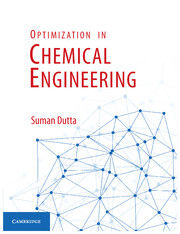Book contents
- Frontmatter
- Dedication
- Contents
- List of Figures
- List of Tables
- Preface
- 1 A Brief Discussion on Optimization
- 2 Formulation of Optimization Problems in Chemical and Biochemical Engineering
- 3 Single Variable Unconstrained Optimization Methods
- 4 Trust-Region Methods
- 5 Optimization of Unconstrained Multivariable Functions
- 6 Multivariable Optimization with Constraints
- 7 Optimization of Staged and Discrete Processes
- 8 Some Advanced Topics on Optimization
- 9 Nontraditional Optimization
- 10 Optimization of Various Chemical and Biochemical Processes
- 11 Statistical Optimization
- 12 Software Tools for Optimization Processes
- Multiple Choice Questions – 1
- Multiple Choice Questions – 2
- Multiple Choice Questions – 3
- Index
- References
5 - Optimization of Unconstrained Multivariable Functions
Published online by Cambridge University Press: 05 February 2016
- Frontmatter
- Dedication
- Contents
- List of Figures
- List of Tables
- Preface
- 1 A Brief Discussion on Optimization
- 2 Formulation of Optimization Problems in Chemical and Biochemical Engineering
- 3 Single Variable Unconstrained Optimization Methods
- 4 Trust-Region Methods
- 5 Optimization of Unconstrained Multivariable Functions
- 6 Multivariable Optimization with Constraints
- 7 Optimization of Staged and Discrete Processes
- 8 Some Advanced Topics on Optimization
- 9 Nontraditional Optimization
- 10 Optimization of Various Chemical and Biochemical Processes
- 11 Statistical Optimization
- 12 Software Tools for Optimization Processes
- Multiple Choice Questions – 1
- Multiple Choice Questions – 2
- Multiple Choice Questions – 3
- Index
- References
Summary
Introduction
When the optimization of an objective function is required without any additional correlation, then this optimization is called unconstrained optimization. Unconstrained optimization problem appears in some cases in chemical engineering. It is the simplest multivariable optimization problem. Parameter estimation is a significant application in engineering and science, where, multivariable unconstrained optimization methods are required. Some optimization problems are inherently unconstrained; there is no additional function (section 2.7, 2.8). When there are some usual constraints on the variables, it is better to ignore these constraints and to consider that they do not have any impact on the optimal solution. Unconstrained problems also formed due to reconstructions of constrained optimization problems, in which the penalization terms are used to replace the constraints in the objective function that have the effect of discouraging constraint violations.
Rarely do we get any unconstrained problem as a practical design problem, the knowledge on this type of optimization problems is essential for the following purposes:
The constraints hold very less influence in some design problems.
To get basic idea about constrained optimization, the study of unconstrained optimization techniques is necessary.
Solving the unconstrained optimization problem is quite easy compared to constrained optimization.
Some robust and efficient methods are required for the numerical optimization of any nonlinear multivariable objective functions. The efficiency of the algorithm is very significant because these optimization problems require an iterative solution process, and this trial and error becomes unfeasible when number of variables is more than three. Generally, it is very difficult to predict the behavior of nonlinear function; there may exist local minima or maxima, saddle points, regions of convexity, and concavity. Therefore, robustness (the capability to get a desired solution) is desirable for these methods. In some regions, the optimization algorithm may proceed quite slowly toward the optimum, demanding excessive computational time. In this chapter, we will discuss various nonlinear programming algorithms for unconstrained optimization.
Formulation of Unconstrained Optimization
For an unconstrained optimization problem, we minimize the objective function that is constructed with real variables, without any limitations on the values of these variables.
- Type
- Chapter
- Information
- Optimization in Chemical Engineering , pp. 86 - 118Publisher: Cambridge University PressPrint publication year: 2016



